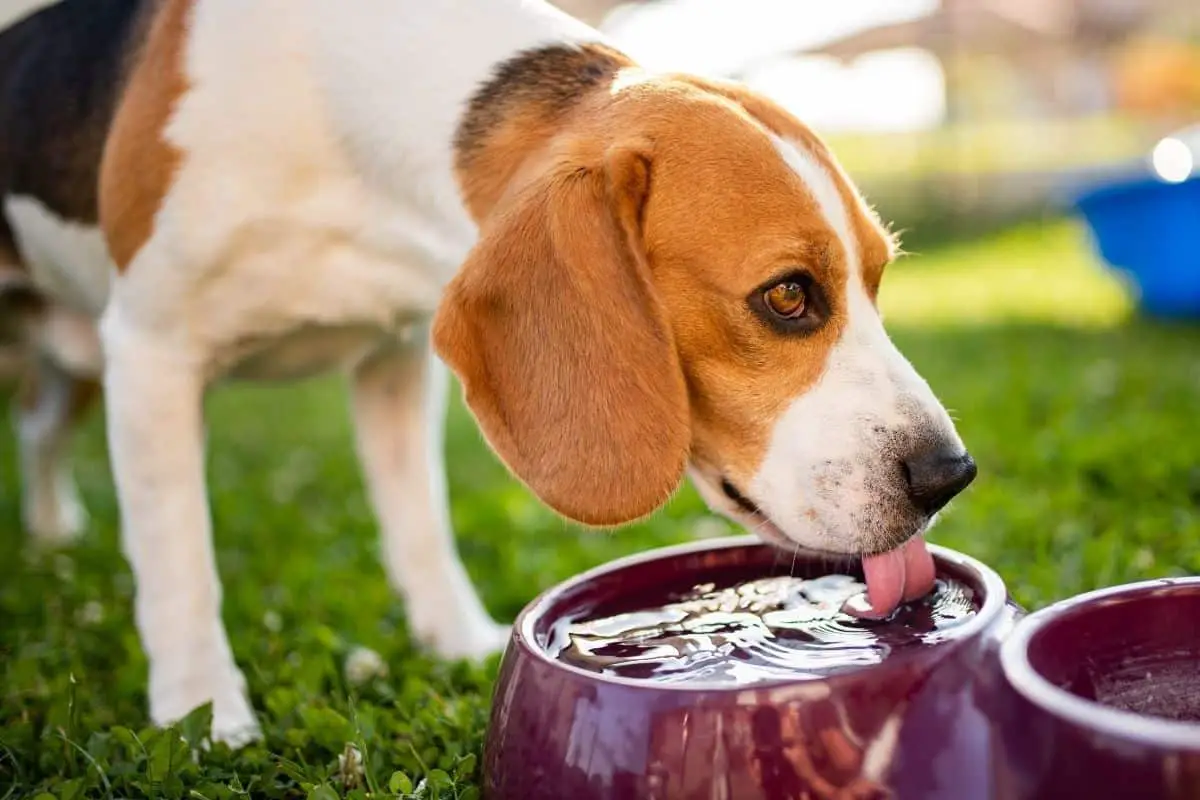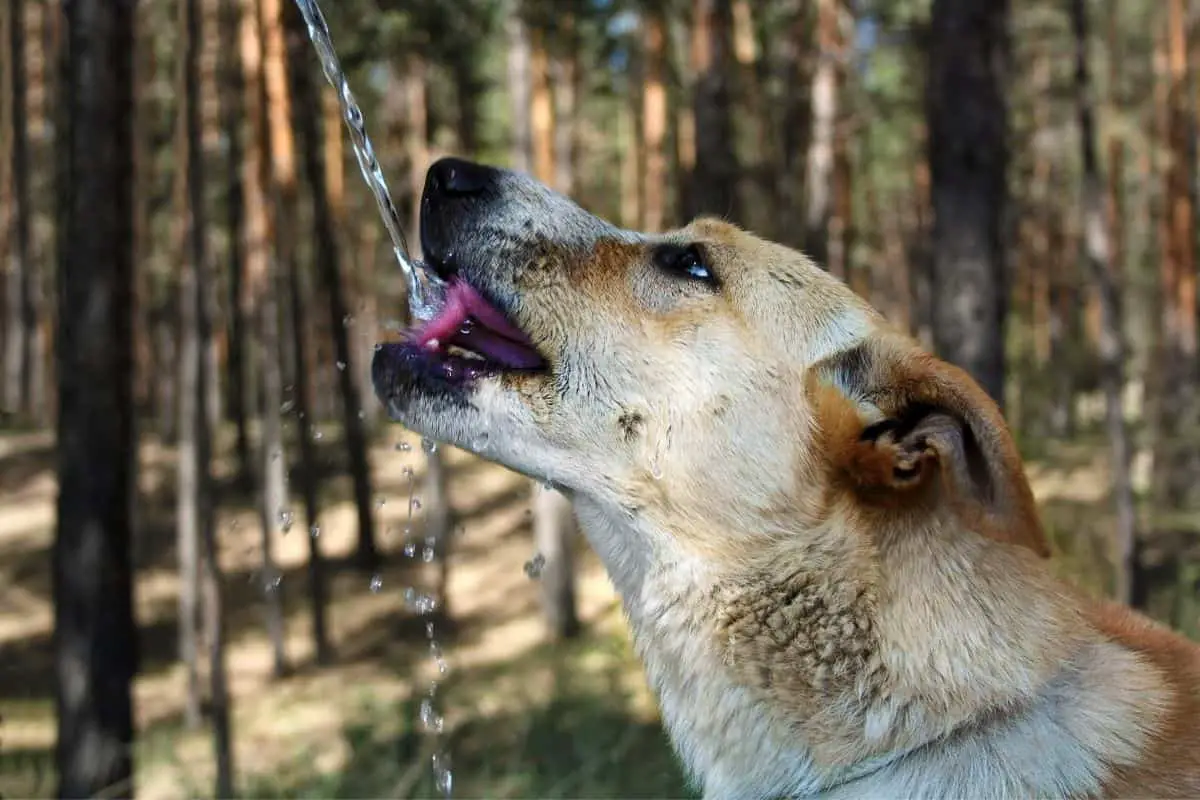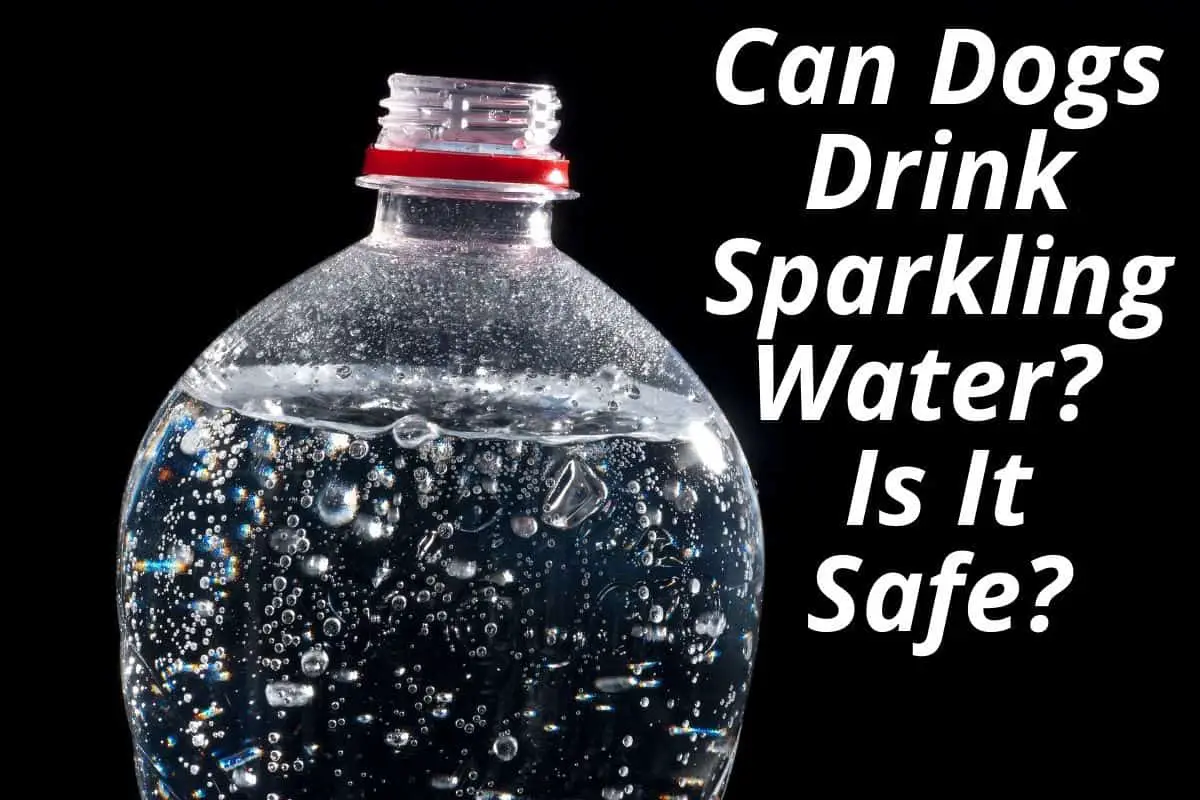This post contains affiliate links.
Did you forget to fill up Fido’s water bowl before running out the door on your way to work this morning? We have all been there – late, frantic, and forgetful as we rush out the door, but how does that affect your best canine companion?
A dog can go eight hours without water. However, it may not be the healthiest decision if you can avoid it. Dogs rely heavily on water to regulate body temperature, support digestion, and promote healthy joints. It is best to allow them access to their bowl throughout the day.
Forgetting to fill up your dog’s water bowl occasionally is one thing, but you should not intentionally leave your pup without water for long periods. This article will cover everything you need to know about your dog’s health concerning water intake and overall hydration.
Table of Contents
How Much Water Should Your Dog Be Drinking?
Like humans, dogs’ bodies are primarily made up of water, which means they need to maintain a certain hydration level to be healthy and comfortable. The amount of water will depend on your dog’s size, so we will teach you a quick calculation.
A good rule of thumb is that a dog should drink one ounce of water for each pound he weighs per day. So, if your dog weighs 50 pounds (22.68 kg), he should drink 50 ounces or 1478.68 milliliters (just over 6 cups) of water each day.
The amount of water he drinks will vary based on many factors, so do not restrict his water intake. Instead, you should monitor how much water he drinks daily and then pay attention to when his intake changes drastically. A sudden and sharp change (increase or decrease) in his water intake could indicate another health issue.
As mentioned, a few factors will influence how much or little your dog drinks on a day-to-day basis. If you feed him food with a higher water content (ex. wet food or a diet high in fruits and vegetables) than kibble, your pet is likely to drink less water. Alternatively, if it is a hot day and you just came home from a long walk, he will probably be very thirsty temporarily.
How To Promote More Water Intake
If you are concerned about whether your dog is drinking enough water, there are a few ways to encourage him to drink a little more.
Keep the bowl clean and replace water daily. You would not want to drink old water in a slimy bowl, and neither does your dog. Water bowls attract bacteria growth because of the contact with your dog’s saliva and stray food particles. It is essential to regularly clean your dog’s water bowl with warm water and soap. You should also replace the water daily because, let’s face it, dogs are messy.
Make his water even more delicious. If you are struggling to get your pup to drink water, one way to encourage hydration is to make their water irresistible. Dog’s love a good broth, so you can add some chicken broth or beef broth to their water, making it extra delicious.
Feed them hydrating foods. If your dog’s diet is 100% kibble, the chances are that he is not getting enough water. It would be a good idea to incorporate hydrating foods such as fruits and vegetables to increase your pup’s water intake. Kibble is extremely dry and does not promote hydration. You can also add some water to the kibble to turn it into more of a mush, although this only needs to happen if your dog refuses water.
Give him ice cubes for a crunchy snack. Many dogs like to chew on ice cubes for fun. If this is your pet, it is an excellent way to increase his daily water intake. And do not worry about his teeth – they were designed for chewing on bones not to hurt their teeth to eat ice the same way it will for humans.
Reward him when he drinks. This classic strategy of modifying behavior will work just as well with encouraging your dog to drink more water. If you have ever been to puppy training, you are familiar with the term positive reinforcement. Simply give your dog a celebratory hug (if he is down for that sort of thing) or a treat when he drinks. Eventually, he will learn to associate drinking water with something positive.
Importance of Hydration
Dogs are similar to humans in many ways, but one big way is how much of our bodies are made up of water. Even more so than humans, dogs’ bodies are comprised of 80 percent water, much higher than our 60 percent. Dogs require hydration for so many reasons. It keeps them healthy and functioning like a playful and happy dog. Here are a few ways that hydration supports your dog’s life.
Supports Digestion
Water is a vital piece of the puzzle when it comes to digestion. When water mixes with the other foods your dog has eaten, it breaks them down further and makes digestion a breeze. It also helps his body absorb nutrients from his food, such as iron or calcium, ensuring he stays strong and healthy as he grows older.
Moves Nutrients
Like a river that carries pebbles and sand, water moves nutrients to the appropriate organ. We all know that certain nutrients aid in different parts of our body (like protein helps build muscle), and water is a massive component of that process. Without it, nutrients will not get absorbed as quickly, and they will not go to the proper organs and muscles.
Lubricates Joints
Joint protection is especially important for bigger dogs, as the older they get, the more pressure is put on their joints. Water is crucial to the process of joint lubrication, which keeps joint pain at bay and cushions the areas between the joints. It makes all movement more manageable and increases mobility for your pet so that they can play fetch for many years.
Indicates Other Health Issues
Paying attention to your dog’s water intake changes can make a huge difference in recognizing other health issues. Many times, the sooner you identify a problem, the easier it is to treat. A sudden increase or decrease in their water consumption can be a big red flag for other health issues in your pet. Always consult your vet if there are significant changes in your dog’s water consumption.
Dehydration
Most of the time, dogs are great at monitoring their own hydration. However, if, for some reason, your dog is not interested in his water bowl, he might get dehydrated quickly. This can lead to a dangerous health situation for your pup, so it is best to avoid it.
Recognizing Dehydration: Signs and Symptoms
It is critical to be informed enough to recognize the signs of dehydration in your dog, especially if he has been left without water for several hours. Informing yourself and others in your household about dehydration signs and symptoms can keep your dog healthy and safe. Dehydration can be extremely dangerous, so stay informed and alert to the symptoms your dog may be exhibiting.
Loss of Appetite
Dehydration can be a vicious cycle because of this symptom. A loss of appetite is a strong indicator that something is wrong, and it could be dehydration. Unfortunately, dogs often get a lot of hydration from their food, worrying when they stop eating. Do your best to encourage your pet to eat and drink, even offering him chicken broth to entice him.
Fatigue or Reduced Energy Levels
This symptom sticks out like a sore thumb, especially for those hyper, high-energy dogs. We hate to see our canine best friends feeling lethargic because it is so apparent that something is wrong. If your dog seems to be more tired than usual, especially if he has not been very active lately, then that is a sign something is wrong.
Dry Nose and Eyes
Some people love it, and some people hate it, but a wet nose to the face is a classic greeting from a dog. Their noses are wet to attract scents and to help regulate their body temperature. If you notice that your dog’s nose becomes dry, it may be a sign of dehydration. Similarly, look out for dry and sunken eyes, as this is a strong indicator of a lack of water for your dog.
Vomiting
Sometimes dogs vomit when they are anxious; other times, they have allergies, or maybe they ate something wrong. However, vomiting is almost always a red flag that something is wrong. If your dog is vomiting due to dehydration, it can quickly become dangerous because they are continually losing fluids. Get a veterinarian involved if your dog is vomiting from a lack of water.
Excessive Panting
Your dog probably pants a lot, especially after a long hot walk or a good game of fetch. It is entirely normal, and it is how they regulate their body temperature. However, if you notice your dog panting for no apparent reason, it could be dehydration. Water is an effective body temperature maintenance method, and without it, they will pant a lot more. Keep an eye out for new or worsening symptoms.
Testing for Dehydration
If your dog is exhibiting one or more of the symptoms listed above, he might be dehydrated. While not every sign is a cause for concern, being aware of them can save your dog’s life. However, it can be challenging to say for sure because so many of those symptoms can be situational, and they may mean nothing at all.
Luckily, there are two quick and easy ways that you can test for dehydration in your dog. If you are concerned that your dog is dehydrated, it is essential to ensure the drinks clean, fresh water immediately. Talk to your vet to determine if other underlying issues are causing the dehydration.
Check His Gums
A dog’s gums can tell us a lot about his health, particularly his hydration or lack thereof. If you open your dog’s mouth and touch his gums, they should be wet and slippery. If you notice that they are sticky or dry, he is dehydrated. Get that pup some water, pronto!
There is one more way you can monitor his hydration using his gums. Using your finger, gently press up against his gums. The pressure from your finger temporarily restricts blood flow allowing you to see how quickly it returns. If the color should return to its natural pink color quickly, within a couple of seconds, then you have nothing to worry about. However, if it takes longer than two seconds, your pup is likely dehydrated.
Check His Neck Scruff
Are you familiar with the extra skin on the back of dogs’ necks? It is where their mother would carry them around like a puppy. Well, this part of a dog is also a great indicator if your pup has been drinking enough water. Gently grab a hold of the scruff and stretch it upwards. When you let go, it should quickly return to its place. However, if it is slow to return or stays upright, that is a strong indicator of dehydration.
Avoiding Dehydration
If you are concerned about your dog getting enough water, there are a couple of ways to ensure he gets the care he needs while you are at work. Continue reading for two suggestions on how to make your life easier while you are gone for several hours per day.
Get a Dog Walker
The first thing you can do is get a dog walker. There are many walking services such as Wag! and Rover, making it extremely easy for you to find dog walkers in your area. You could probably find a high school or college student in your neighborhood, too.
Walkers are typically affordable and have a genuine love for pets, so this is a great option. A walker would ensure your pet goes to the bathroom and could refill his water midday so you know he will not get dehydrated.
Get a Large Water Dispenser
One other suggestion is to get a large water dispenser. These nifty gadgets are great for owners who frequently find themselves forgetting to refill the water bowl. They are affordable and often hold multiple gallons at a time. If this sounds like a product you need, check out this Gravity Pet Water Dispenser from Amazon Basics. Keep in mind that this product might not be ideal for puppies that are potty training.
What if Your Dog Is Dehydrated?
Of course, the best thing you can do for a dehydrated dog is to give him fresh, clean water. Most dogs are naturally really good at drinking appropriate amounts of water to be concerning when they are not interested in their water bowl.
It is always better to be safe than sorry. If you think your dog is dehydrated, calling your vet is the safest approach, especially if he does not seem interested in the water you offer him. Furthermore, as I have mentioned, dehydration is often a symptom of another underlying health condition, so you must work with a vet to get to the bottom of it.
Final Thoughts
Prolonged periods without water can damage a dog’s health, resulting in dangerous side effects such as vomiting, loss of appetite, and fatigue. Stay informed about the signs and symptoms of dehydration in your pet, and pay attention to his daily habits so you’ll know when things are out of the ordinary.
Canine dehydration is no joke. Dogs rely on water for many essential bodily functions such as digestion, body temperature regulation, and joint health. If you forget to fill your dog’s water before you leave for work, he’ll be okay for the day. However, it’s best to avoid making this a habit.
Related Articles
- Can Dogs Drink Sparkling Water? (Is It Safe?)
- What Can Dogs Drink Besides Water? (We Ask the Experts)
- Can Dogs Drink Coconut Water? Let’s Find Out!
- Can Dogs Drink Distilled Water? Let’s Find Out
- How Long Can Dogs Go Without Water? (We Ask the Experts)
- My Dog Drank Pool Water: Here’s What To Do About It
- Dog Water at Night – When To Cut Them Off
- Considering Forcing a Dog To Drink Water? (Read This First)
Sources
- Richell USA: Canine Hydration – The Importance of Water in a Dog’s Diet
- American Kennel Club: Warning Signs of Dehydration in Dogs
- Small Dog Place: Dehydration in Dogs: How Long Can a Dog Go Without Water?
- American Kennel Club: Is Your Puppy Drinking Enough Water?
- PetMD: How Much Water Should a Dog Drink?
Mrdogfood.com is a participant in the Amazon Services LLC Associates Program, an affiliate advertising program designed to provide a means for sites to earn advertising fees by advertising and linking to Amazon.com. We also participate in other affiliate programs which compensate us for referring traffic.





